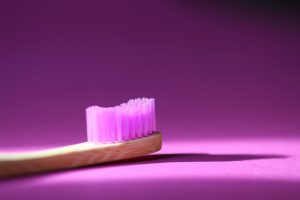How to Remove Wine Stains from Your Teeth
Wine is arguably the alcohol with the best reputation. It’s seen as classier and more socially acceptable, and we often hear that drinking it in moderation even offers some health benefits. Like other types of alcohol, however, wine can have a negative impact on both your physical health and appearance over time, including tooth stains.
While stained teeth won’t directly damage your health, they may damage your confidence. So, are wine stains on your teeth permanent? What can you do to remove these wine stains, or to prevent them from happening in the first place?
First Things First: Does Wine Stain Your Teeth?

Photo by Joey Nicotra on Unsplash
The short answer to this question is: Yes. Wine can stain your teeth in both the short term and the long term. During an evening of wine drinking, you may notice your teeth have taken on an unsightly purplish color. Fortunately, you can brush and rinse this color off.
Unfortunately, more long-term drinking frequently leads to long-term stains. Teeth may appear duller and more brown, gray, or bluish-purple.
Wine stains your teeth for three main reasons: acid, tannins, and naturally occurring dyes called chromogens.
Does Red Wine Stain Teeth?
Red wine teeth stains are especially common. That’s because red wine contains high levels of all three staining components: acid, tannins, and chromogens.
Acid breaks down tooth enamel, which is the thin outer covering of the tooth. Worn enamel makes your teeth more vulnerable to damage and decay. As the enamel erodes, teeth may also begin to appear yellow.
Tannins are chemical compounds that give wine its bitterness and astringency, while chromogens are chemical compounds that give red wine its color. Both may cling to weakened enamel, resulting in dull, stained, or discolored teeth.
Does White Wine Stain Teeth?
White wine won’t stain your teeth as noticeably as red wine in the short term. It doesn’t have the chromogens found in red wine, and it has far lower tannin levels.
Still, the high acidity of white wine contributes to long-term tooth staining. The acid in white wine can dissolve tooth enamel, potentially discoloring your teeth and making them more susceptible to stains. For example, if you frequently drink white wine and also drink tea, coffee, or red wine, these beverages will stain your teeth more easily than otherwise.
How to Get Red Wine Stains Off Teeth

Photo by Anne Nygård on Unsplash
Luckily, there are several methods to get red wine stains off teeth. For those short-term purplish stains, try drinking water and lightly swishing it around your mouth. You can also purchase wine wipes, a product specifically designed to fight off wine stains.
Another tip is to eat cheese while drinking wine. Wine and cheese are already a great pairing, and eating naturally produces saliva. Saliva rinses plaque, bacteria, and short-term color stains from your teeth. Plus, cheese contains calcium, strengthening the enamel instead of breaking it down.
If you’ve noticed more long-term staining, some toothpastes and home whitening kits may help. However, some home whitening kits actually break down tooth enamel, ultimately making matters worse. Consult with your dentist first, or consider professional whitening in a dentist’s office.
How to Prevent Wine Stains on Teeth
Better yet, how can you prevent wine stains on your teeth in the first place? One helpful strategy is to brush your teeth before drinking wine. Stains actually stick to the plaque on your teeth. Making sure your teeth are squeaky clean before drinking wine means your teeth are less vulnerable to staining. You should also brush your teeth about 30 minutes after drinking wine.
Enamel-strengthening toothpastes and mouthwashes can prevent acid from weakening tooth enamel, also making teeth less vulnerable to stains. Using a straw while drinking is another useful method, since it minimizes the wine’s contact with your teeth. Of course, regular visits to the dentist also help with prevention, as well as catching other potential issues before they become more severe.
Finally, keep in mind that the darker the wine, the more likely it is to stain your teeth. Switch to lighter drinks, or consider cutting back on your alcohol consumption.
If you’re thinking about making a change, Ria Health can help. Our approach is customizable, realistic, and flexible. You set your own goals, and we support you in reaching them.
Will insurance cover treatment? Verify Coverage
Have Questions? Call (800) 504-5360



